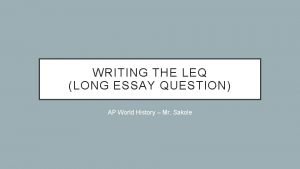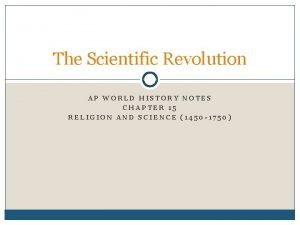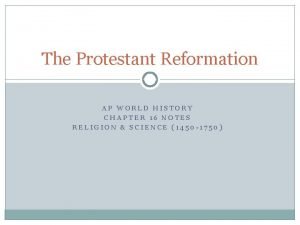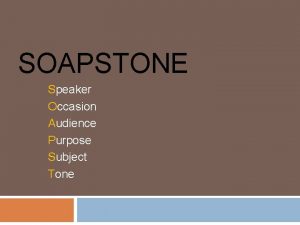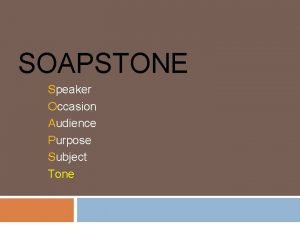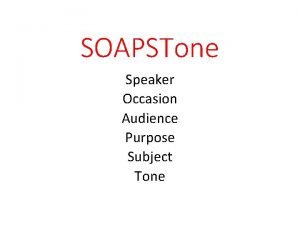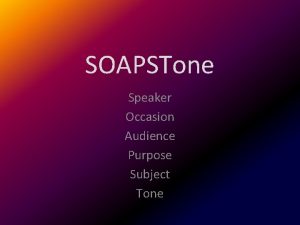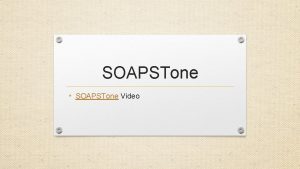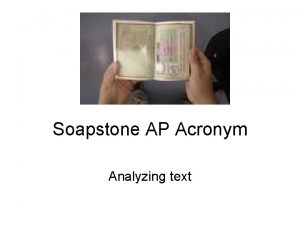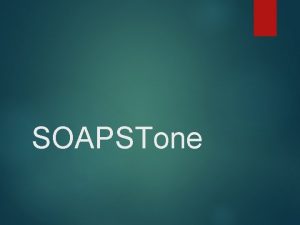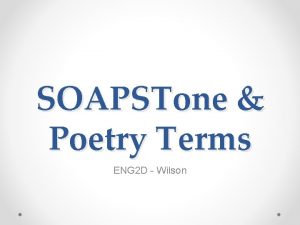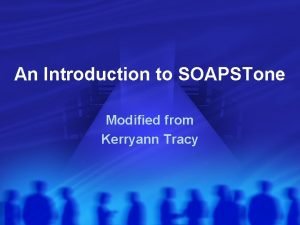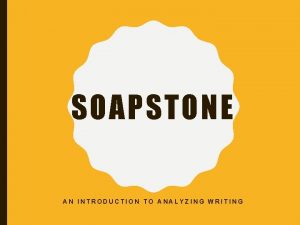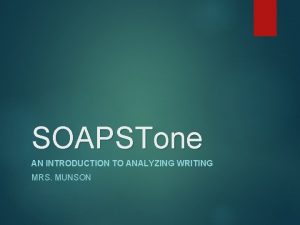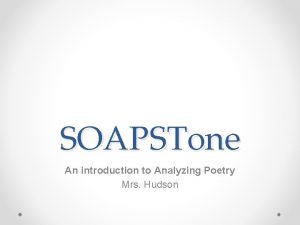An Introduction to SOAPSTone Maconald AP World History




















- Slides: 20

An Introduction to SOAPSTone Maconald AP World History

Notes, Considerations Speaker Occasion Audience Purpose Subject Tone

S O A P S T o n e Who is the Speaker? It is not enough simply to name the speaker. What assumptions can you make about the speaker (e. g. , age, gender, class, occupation, emotional state)? What does the speaker believe? What is the speaker’s point of view (WHY is he/she writing or saying what they are at this point). Do not assume that the author believes what the speaker believes. Include important facts about the speaker if known that might help you make judgments about his or her point of view.

S O A P S T o n e What is the Occasion? Occasion is not simply identifying the time and place. Consider the larger occasion or context: what is going on in the rest of the world that would cause the author to write this?

S O A P S T o n e Who is the Audience? To whom is this text directed? It’s not enough to say: “Anyone who reads it. ” Is it one individual, a group, many groups? Why? For what purpose? What assumptions can you make about the intended audience?

S O A P S T o n e What is the Purpose? What is the speaker’s reason for writing the text? What is its intended effect? How is it supposed to make the audience feel? What change does the author want to see as a result? Is the author’s aim to entertain, to inform, to persuade, to critique, to complain, to explain, to describe, or to reflect? Consider that oftentimes writers have a dual purpose.

S O A P S T o n e What is the Subject? The subject is the general topic, content, and ideas or themes contained in the text. This can usually be stated in a few words or a phrase. The subjects of texts are frequently specific and abstract at the same time: the right to die, racism, poverty, conformity, cloning, global warming, etc.

S O A P S T o n e What is the Tone? Tone is the attitude of the speaker towards his subject. What emotional sense do you take from the piece? Does it stay consistent throughout, or do the speaker’s feelings shift? While the spoken word can easily convey attitude through inflection, tone is often difficult to discern in the written word. Consider how word choice, sentence structure, and imagery might point to tone. Why might the author choose that tone? What can that help us deduce about his/her purpose?

Talking About Tone aggravated ambiguous amused angry apathetic apologetic appreciative apprehensive arrogant dramatic ecstatic effusive elated elegiac factual fanciful flippant foreboding moralistic mournful nostalgic objective outraged passionate patronizing pedantic perplexed

SOAPSTone Application: “I Have a Dream” At your table, do a Close Read Underline main arguments / idea Circle words you don’t know Notes/ connections in margins

SOAPSTone Application: “I Have a Dream” Complete a SOAPStone analysis after you read. Be prepared to share your answers

SOAPSTone Application: “I Have a Dream” Speaker King was one of many speakers that day. What distinguished him from the others – as a man, a prominent figure in the civil rights movement, or a public speaker? In addition, you might consider that King was both a preacher and the son of a preacher. How does this background manifest itself in the speech?

SOAPSTone Application: “I Have a Dream” Occasion What is important to understand about the historical context of this speech? Consider both the general background (the Civil Rights Movement), and this particular occasion (the March on Washington). How does King himself frame the occasion?

SOAPSTone Application: “I Have a Dream” Audience Who comprises King’s audience? Which audiences are explicit (directly named) and which might be implicit (implied but not named)? Where in the speech does he address specific audiences?

SOAPSTone Application: “I Have a Dream” Purpose What changes does King want to see as a result of this speech? What other purpose(s), beyond advocating change, do you see in King’s speech?

SOAPSTone Application: “I Have a Dream” Subject The event was billed as a march “for jobs and freedom. ” What other topics or issues, beyond these, does King address in his speech?

SOAPSTone Application: “I Have a Dream” Tone How would you characterize the tone of King’s speech? Where do you see significant shifts in tone?

SOAPStone Carousel Station 1 1. At your first station read your piece and fill in the graphic organizer except the T part. Leave your work behind. Think about what you learned by working with your team.

SOAPStone Carousel Station 2 At station 2 read the piece and the previous group’s work. Describe what you believe is the TONE of the piece. Write it in a complete sentence.

SOAPStone Carousel Station 3 You have reached your last station. Read the piece and the last groups’ work on the SOAPStone sheet. Get ready to share their work. Agree or disagree with their statements about the tone. Find supporting phrases or passages to support or refute their claim. (EVIDENCE)
 Soapstone history
Soapstone history Soaps chart example
Soaps chart example Ap world history chapter 25 africa and the atlantic world
Ap world history chapter 25 africa and the atlantic world Countries michael jackson visited
Countries michael jackson visited History also history physical
History also history physical Leq complexity point
Leq complexity point Total war world history definition
Total war world history definition Chapter 17 section 3 luther leads the reformation
Chapter 17 section 3 luther leads the reformation World history spring final exam review answers
World history spring final exam review answers Ap world history jeopardy
Ap world history jeopardy Chapter 32 assessment world history
Chapter 32 assessment world history Chapter 30 section 2 world history
Chapter 30 section 2 world history What was the counter-reformation?
What was the counter-reformation? World history final exam study guide
World history final exam study guide Manorial system ap world history
Manorial system ap world history Mrs turnbull world history
Mrs turnbull world history Prince henry the navigator ap world history
Prince henry the navigator ap world history Scientific revolution ap world history
Scientific revolution ap world history Chapter 16 lesson 1 the protestant reformation
Chapter 16 lesson 1 the protestant reformation Chapter 13 ap world history notes
Chapter 13 ap world history notes Climate change definition ap world history
Climate change definition ap world history





